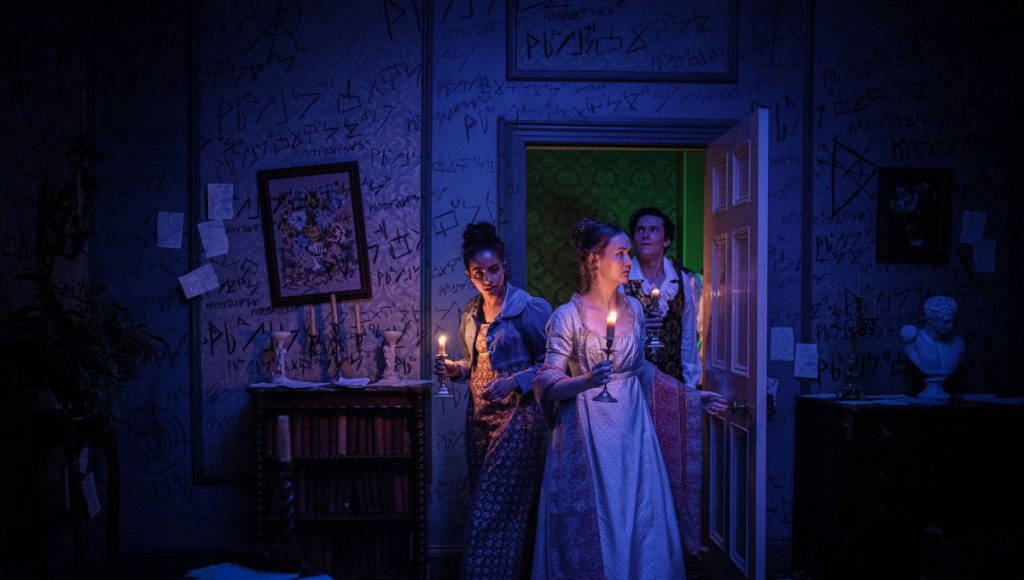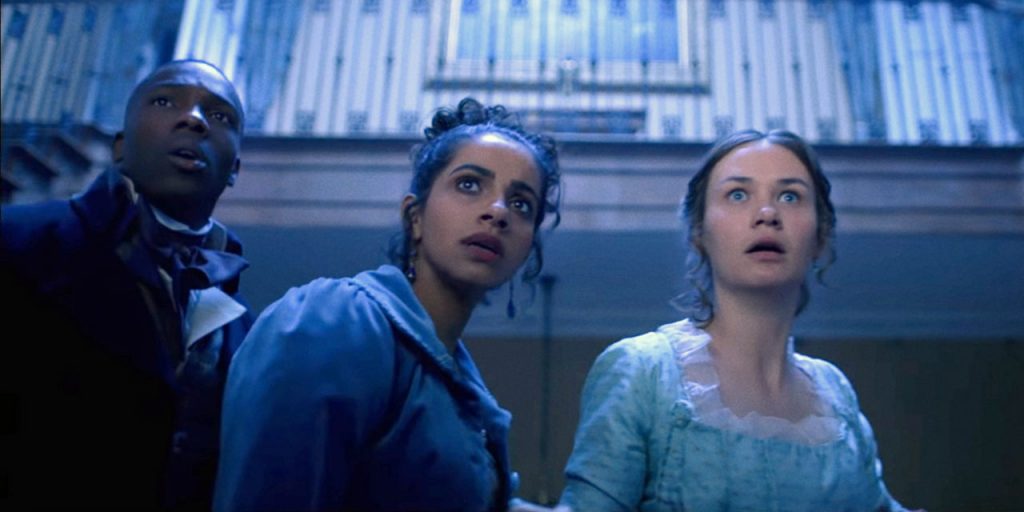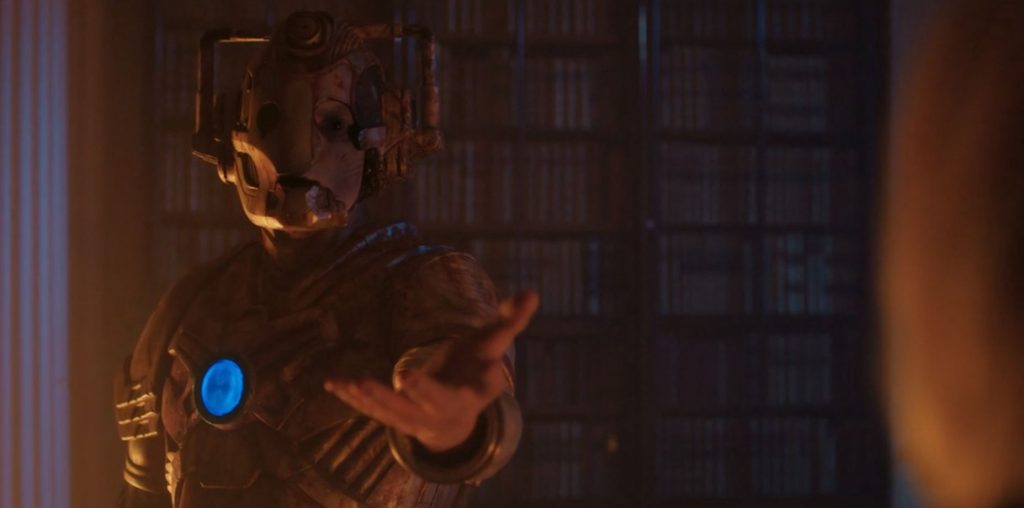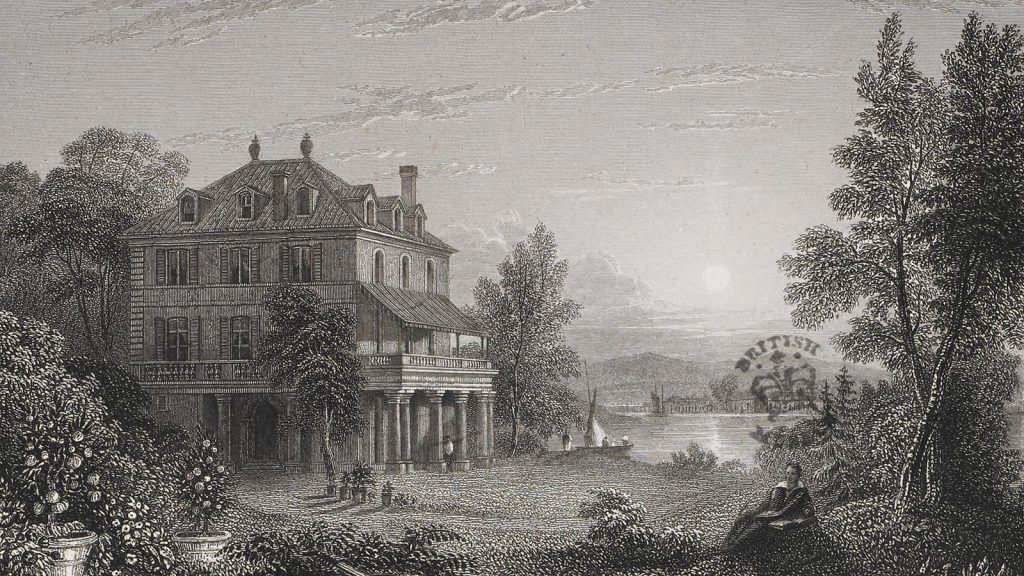Review by Paul Mount
Written by Maxine Alderton & Chris Chibnall
Directed by Emma Sullivan

Image: BBC
“Nobody mention Frankenstein. Nobody interfere. Nobody snog Byron.” Should be easy, right?
The Doctor and her gang arrive at the Villa Diodati at Lake Geneva in 1816 on the night that inspired Mary Shelley’s Frankenstein. The plan is to spend the evening soaking up the atmosphere in the presence of some literary greats, but the ghosts are all too real, and the Doctor is forced into a decision of earth-shattering proportions…
The day before episode eight of the current season of Doctor Who aired on BBC1 in the UK, news filtered through from the Gallifrey One convention in Los Angeles that Tracie Simpson, one of the show’s long-time executive producers, had announced (to a presumably aghast crowd) that production of season 13 will commence in September this year.
The news spread like wildfire, of course, and fans were forced to resort to taking off their socks and shoes to help them “do the math” and work out that, with a series taking the better part of a year to make these days, we won’t be seeing Season 13 until Autumn 2021 at the earliest. This may or not be a good thing (and in itself is not hugely unusual in the modern era, where the show’s production has been increasingly haphazard since about 2012).
Season 12 has been, broadly, a better fit than season 11 but it’s clear that the show has drifted alarmingly out of the public consciousness, with last week’s episode, Can You Hear Me?, dropping out of the UK’s Top 30 viewing chart, the first episode to do so since the series triumphantly returned in 2005. (This is, partly, due to the BBC’s peculiar decision to jam it into a Sunday evening schedule it’s clearly not a good fit for and then pretty much stopping actively promoting the series).
Something clearly needs to be done; the show needs to be retooled, reformatted, reinvigorated – and clearly the casting of the first female Doctor hasn’t been enough to reverse the fortunes of a show which has been struggling for several years. Change may be in the air; and not a moment too soon. And yet…
Frustratingly – perhaps when the wind is in the right direction and the moon is in the ascendant – the show is still capable of delivering something very different, a sit-up-and-take-notice episode like The Haunting of Villa Diodati – and suddenly the prospect of having to wait the better part of two years for a fresh fix of Doctor Who episodes seems almost unbearable. This is modern Doctor Who firing on all cylinders, a beguiling and slickly-executed collision between classic horror and hard-core sci-fi that suddenly brings the side-lined ‘series arc’ back into sharp relief as we head towards the two-part ’season finale’ and adds some much-needed grit and steel into the relationship between the Doctor and her “fam” (oops).
As hinted at the end of the previous episode, the Doctor has taken her chums off to June 1816 and the rain-lashed Villa Diodati on the banks of Lake Geneva. Here a bunch of the greatest creative thinkers of the age – the oily Lord Byron, Mary Godwin (later Mary Shelley), John Polidori and Claire Clairmont – are sitting out the unseasonably-inclement weather. But when the Doctor and company arrive, it’s clear that something is wrong at this particular moment in Time – the period during which, history tells us, the group famously spent three nights together inside the house creating stories to tell each other (leading, of course, to the creation of Mary Shelley’s Frankenstein and John Polidari’s The Vampyre).
Percy Shelley is missing from the gathering and the group are listless and playful, happier to indulge themselves with dancing and flirting rather than settling down to the serious business of scaring their britches off one another. The Doctor’s interest is, naturally enough, piqued, especially when she’s told about a mysterious glowing figure that hovers above the lake.
Throw in some ghostly manifestations, a scary scuttling skeletal hand, unearthly bodily possession, Ryan (Toisin Cole) challenged to a duel and Graham (Bradley Walsh) desperately looking for a loo and we’ve got a wonderfully creepy, edgy, chamber piece horror story that reminds us how good this show can be when all its moving parts are working together in perfect unison. Doctor Who has dabbled with horror before, of course; in the 1970s producer Phillip Hinchliffe gave the early Tom Baker years a real Gothic flavour, with stories that dabbled with the themes and tropes (and quite often the stories themselves) of both Universal and Hammer horror movies (in a bloodless Saturday night TV fashion) and the new series has often danced around the edges of the horrific.
In The Unquiet Dead in its very first new season Christopher Eccleston’s Doctor encountered reanimated corpses and aliens made of gas, 2006’s Tooth and Claw offered an alien werewolf stalking the corridors of a remote Scottish country castle and 2013’s Hide saw the tenth Doctor and Clara visiting an apparently “haunted” house. But The Haunting of Villa Diodati takes the gloves off and goes for the jugular; as ever, of course, the horror is bloodless but suggestive and, of course, it all (well, almost all…) has a rational explanation, albeit one delivered in great gushing spurts of technobabble by our reliably-breathless Mrs Doctor.
The Haunting of Villa Diodati is eerie enough in its first twenty-odd minutes. There’s something intrinsically unnerving about dark, stormy nights, isolated houses, shadowy corridors and things that go bump in the night. But Maxine Alderton’s excellent debut Doctor Who script really turns the screw, piling on the tension and delivering some moments surely designed to make even the hardiest heart wonder if ‘behind the sofa’ might not be the safest place to hide. The image of a skeletal hand emerging from a painting and dashing around the house, finally settling, Alien-style, on Ryan’s face, is the stuff of many a junior nightmare.

Mandip Gill as Yaz, Lili Miller as Mary Wollstonecraft Godwin, Jacob Collins-Levy as Lord Byron in Doctor Who – The Haunting Of Villa Diodati. Photo Credit: James Pardon/BBC Studios/BBC America

Image: BBC
The story starts to become seriously weird and unpredictable, however, when the entire structure of the villa seems to shift recursively, the Doctor and friends wandering around the villa but always ending up in the same place, unable to move from one room or stairwell. Is the house playing supernatural games with them or is something working to keep them in the villa to prevent them – or something or someone else – getting out?
If the episode wasn’t already dark and disquieting enough, things take a turn for the seriously-disturbing when the identity of the creature seen above the lake is revealed. It’s an alien creature moving through Time, trying to find a way into the villa – a Cyberman, but a Cyberman like no other we have ever seen before. It’s also a lone Cyberman… and we, like the Doctor and team, remember Captain Jack’s warning from Fugitive of the Judoon a few weeks ago…

Image: BBC
The Cybermen haven’t always been best-served by the modern series. They’ve been slightly redesigned and upgraded from time to time but the scripts have rarely properly got to grips with the core concept of humanoid creatures who willingly surrender their humanity for the sake of the survival of their species. The Cybermen are creatures who sacrifice their very bodies so that their race can thrive and multiply and, in doing so, they become inhuman, unemotional, rational machine-men dedicated to conquest and destruction. The ‘body horror’ element of their plight is rarely addressed or considered (and when it is – for example, by previous showrunner Steven Moffatt during the Peter Capaldi era – it’s usually fudged at the altar of fan service). But The Haunting at Villa Deodati strips the entire idea of the Cybermen right back to basics and makes the creatures more terrifying and horribly-plausible than ever before.
This lone Cyberman is pretty much half-human; he’s called Ashad and his Cybersuit is falling apart, his mutilated human features visible underneath a shattered faceplate and he’s clearly in touch with his lost human emotions even if he’s absolutely not in thrall to them. He has been drifting through Time in search of a power-source called the Cyberium, a liquid metal which contains the collective knowledge of the Cyber race, which is vital to the future of the Cybermen as they fight the legendary Cyberwar (referenced several times in the series in the past).
The Cyberium’s connection to the Villa is startling even as it resolves one final great mystery – the whereabouts of Percy Shelley – and eventually the Doctor appears to make the ultimate sacrifice as she herself absorbs the power of the Cyberium purely so the Cybermen can’t get their hands on it. But the lone Cyberman has one last great option… and the Doctor has to choose between the fate of one man and one planet or the fate of the entire Universe.

Image: BBC
Jodie Whittaker explodes off the screen here in the scenes where she makes her choice and explains just why she can’t always win and why, ultimately, the responsibility remains with her no matter who she surrounds herself with.
It’s stronger scripting this year and several powerful moments like this that have finally allowed Jodie Whittaker to ‘seal the deal’ on her interpretation of the Doctor. Who historians – and the sad fact that she, like her predecessor, clearly hasn’t struck a chord with a large audience – will, perhaps, never mark her era down as a highpoint in the show’s long history, but she’s starting to acquit herself well now and she’s at her best when she sets aside the comic bumbling and bantering and is allowed to dig deep into the Doctor’s own morality and strength of character in times of crisis.
The Haunting at Villa Diodati ends with the Doctor and company setting off with information gleaned from the Cyberium to follow the lone Cyberman into the future.
It could be argued that the episode is merely a prelude to a larger-scale two-part finale, in the way that 2007’s Utopia set the scene for the Sound of Drums/Last of the Time Lords finale. But that would do Villa Diodati a disservice; it’s a better episode than Utopia in its own right (sorry, Russell), with a meatier story, better production and a script that delightfully toys with our expectations of its scenario by delivering chills, thrills and some wonderful little touches (the Cyberman recharging himself from a lightning strike, Mary Godwin’s thoughtful confrontation with the alien which is clearly setting her creative wheels in motion). There are some understated moments of proper horror too – the Cyberman off-handedly killing the nanny of Mary and Percy’s baby, who is itself replaced in the crib by a skull and a skeletal hand and the scene where the Cyberman appears to be wrestling with his humanity; only to relish the revelation that he slit his own children’s throats when they joined the resistance movement. Doctor Who rarely allows itself to get quite so deliciously dark.
The Haunting of Villa Diodati is a welcome addition to the smattering of truly great game-changing episodes which have been scattered throughout this season. If the show is shortly to vanish from our screens (barring the already-filmed festive special… you’ve got to be ready for that one) for eighteen months or more, we can at least hope that Chris Chibnall and his team can use whatever downtime the show’s punishing schedule allows to come up with more rich, powerful stories of this quality and dispense with tedious filler like Praxeus and Orphan 55.
This is Doctor Who at something approaching its 21st century best and it’s nothing less a televisual tragedy that, for whatever reasons, it’s no longer chiming with a larger proportion of the British viewing public. They’re missing out.
Paul Mount
• Pre-Order Doctor Who Series 12 on Blu-Ray | DVD
WEB LINKS
• Doctor Who – The Haunting of Villa Diodati BBC

The Villa Diodati, also then known as Hotel d’Angleterre, where Percy Shelley, Mary Wollstonecraft Godwin, Lord Byron and John Polidori decided to write ghost stories in the summer of 1816. This led to the publishing of “Frankenstein” in 1818
1816: “The Year Without Summer”
The weather in the summer of 1816 was memorable for all the wrong reasons. The eruption of Mount Tamboro in Indonesia in April 1815 sent clouds of volcanic ash billowing into the upper atmosphere. The sun was obscured; levels of rainfall increased and temperatures fell. The summer of the following year was thus dismal and damp, with low temperatures and torrential rain causing disastrous crop failures throughout North America, Europe and Asia. For many living on the other side of the world to the eruption, the reason for the disturbances in the weather would have been a mystery, but one that lent a sinister and perhaps even a supernatural quality to the need to light candles at midday as darkness descended, and the sight of birds settling down to roost at noon. The discovery by scientists of large dark spots on the sun in the same year added to the growing sense of unease and impending doom, as reflected in Lord Byron’s apocalyptic poem Darkness, written in Geneva in July 1816.
“The year without a summer”, as 1816 became known, provided the perfect backdrop to the telling of bleak, macabre and doom-laden Gothic tales.
Doctor Who © BBC
Dear Readers: A review is an opinion. Other opinions are available
One of many guest posts for downthetubes.
Categories: Doctor Who, downthetubes News, Features, Other Worlds, Reviews, Television
 In Review: Timeslides: The Doctor Who Artwork of Colin Howard
In Review: Timeslides: The Doctor Who Artwork of Colin Howard  In Review: The Illustrated Journey: A Visual Celebration of Doctor Who
In Review: The Illustrated Journey: A Visual Celebration of Doctor Who  Doctor Who: Worlds of Wonder Exhibition
Doctor Who: Worlds of Wonder Exhibition  Panini releases second “Daleks: The Ultimate Comic Strip Collection”
Panini releases second “Daleks: The Ultimate Comic Strip Collection”